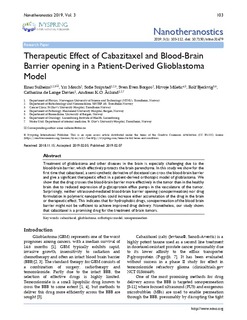| dc.contributor.author | Sulheim, Einar | |
| dc.contributor.author | Mørch, Ýrr Asbjørg | |
| dc.contributor.author | Snipstad, Sofie | |
| dc.contributor.author | Borgos, Sven Even F. | |
| dc.contributor.author | Miletic, Hrvoje | |
| dc.contributor.author | Bjerkvig, Rolf | |
| dc.contributor.author | Davies, Catharina de Lange | |
| dc.contributor.author | Åslund, Andreas | |
| dc.date.accessioned | 2020-02-07T10:17:39Z | |
| dc.date.available | 2020-02-07T10:17:39Z | |
| dc.date.created | 2019-11-22T10:45:49Z | |
| dc.date.issued | 2019 | |
| dc.identifier.citation | Nanotheranostics. 2019, 3 103-112. | nb_NO |
| dc.identifier.issn | 2206-7418 | |
| dc.identifier.uri | http://hdl.handle.net/11250/2640300 | |
| dc.description.abstract | Treatment of glioblastoma and other diseases in the brain is especially challenging due to the blood-brain barrier, which effectively protects the brain parenchyma. In this study we show for the first time that cabazitaxel, a semi-synthetic derivative of docetaxel can cross the blood-brain barrier and give a significant therapeutic effect in a patient-derived orthotopic model of glioblastoma. We show that the drug crosses the blood-brain barrier more effectively in the tumor than in the healthy brain due to reduced expression of p-glycoprotein efflux pumps in the vasculature of the tumor. Surprisingly, neither ultrasound-mediated blood-brain barrier opening (sonopermeation) nor drug formulation in polymeric nanoparticles could increase either accumulation of the drug in the brain or therapeutic effect. This indicates that for hydrophobic drugs, sonopermeation of the blood brain barrier might not be sufficient to achieve improved drug delivery. Nonetheless, our study shows that cabazitaxel is a promising drug for the treatment of brain tumors. | nb_NO |
| dc.language.iso | eng | nb_NO |
| dc.publisher | Ivyspring International Publisher | nb_NO |
| dc.rights | Navngivelse-Ikkekommersiell 4.0 Internasjonal | * |
| dc.rights.uri | http://creativecommons.org/licenses/by-nc/4.0/deed.no | * |
| dc.subject | Cabazitaxel | nb_NO |
| dc.subject | Glioblastoma | nb_NO |
| dc.subject | Orthotopic model | nb_NO |
| dc.subject | Sonopermeation | nb_NO |
| dc.title | Therapeutic Effect of Cabazitaxel and Blood-Brain Barrier opening in a Patient-Derived Glioblastoma Model | nb_NO |
| dc.type | Peer reviewed | nb_NO |
| dc.type | Journal article | en_US |
| dc.description.version | publishedVersion | nb_NO |
| dc.rights.holder | This is an open access article distributed under the terms of the Creative Commons Attribution (CC BY-NC) license (https://creativecommons.org/licenses/by-nc/4.0/). See http://ivyspring.com/terms for full terms and conditions | nb_NO |
| dc.source.pagenumber | 103-112 | nb_NO |
| dc.source.volume | 3 | nb_NO |
| dc.source.journal | Nanotheranostics | nb_NO |
| dc.identifier.doi | 10.7150/ntno.31479 | |
| dc.identifier.cristin | 1750860 | |
| dc.relation.project | Norges forskningsråd: 240316 | nb_NO |
| dc.relation.project | Regionalt helseforetak: 900000 | nb_NO |
| cristin.unitcode | 7401,80,1,0 | |
| cristin.unitname | Bioteknologi og nanomedisin | |
| cristin.ispublished | true | |
| cristin.fulltext | original | |

